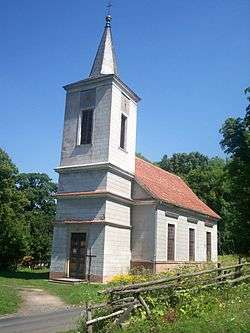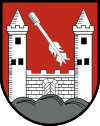Miedzianka, Lower Silesian Voivodeship
| Miedzianka | |
|---|---|
| Village | |
 | |
 Miedzianka Location of Miedzianka, Lower Silesian Voivodeship | |
| Coordinates: 50°52′40″N 15°56′40″E / 50.87778°N 15.94444°ECoordinates: 50°52′40″N 15°56′40″E / 50.87778°N 15.94444°E | |
| Country |
|
| Voivodeship | Lower Silesian |
| Powiat | Jelenia Góra |
| Gmina | Janowice Wielkie |
| Elevation | 500 m (1,600 ft) |
| Population | 80 |
Miedzianka [mjɛˈd͡ʑaŋka] (German: Kupferberg)[1] is a village in the administrative district of Gmina Janowice Wielkie, within Jelenia Góra County, Lower Silesian Voivodeship, in south-western Poland.[2] Prior to 1945 it was in Germany.
It lies approximately 16 km (10 mi) east of Jelenia Góra, and 82 km (51 mi) west of the regional capital Wrocław and has a population of a little over eighty.[3]
History
The settlement's history begins in the 14th century, then known as Coppferberge, Kopferberg, Kupferberg,[1] was split from Waltersdorf (Mniszków).[3] It grew as a copper mining town, and received city rights in 1519.[3] For a time, it was home to about 160 mining excavations and several metallurgical facilities, but this boom came to a halt by the end of the 16th century, as techniques proved insufficient for further exploitation.[3] Around the 17th century the mining sector in Kupferberg began to grow again, under the patronage of a new owner, the count von Promnitz of Pszczyna.[3] The city suffered several fires, in 1637, 1643, 1728 and 1824.[1] In the early 18th century Kupferberg housed a regional mining office.[3] In addition to mining, the town also had a renowned brewery, and from the mid-19th century, it became a popular tourist destination, known as the second most highly located town in the Sudeten Mountains.[3]
Prior to 1945 the town was part of Germany. After World War II the region was placed under Polish administration and ethnically cleansed according to the post-war Potsdam Agreement. The native German populace was expelled and replaced with Poles. Kupferberg, renamed Miedzianka and part of the Polish People's Republic, became a site of a secret Red Army mining operation, as Soviet experts expected to develop a uranium mine there.[3] From 1949 to the 1950s about 600 tons of uranium were sent from Miedzianka to the USSR.[4] Extensive and wanton mining caused much damage to the town, and when the uranium deposits proved to be insufficient for continued exploitation, the local economy collapsed amid the government's attempts to hide the uranium excavation.[1][3] The mine was publicly labelled as a "paper factory"; Polish and Soviet troops and secret police guarded the mine, and the miners who could not keep the secret were executed.[4][5]
In the late 1960s, the planned destruction of Miedzianka begun, with demolitions of selected buildings, and a ban on repairs for remaining ones.[1][4] Around 1972 most inhabitants were resettled to the town of Jelenia Góra.[3] As of 2012 the town of Miedzianka has only about 80 inhabitants.[3]
References
- 1 2 3 4 5 "Dlaczego Miedzianka musiała zniknąć? | Nie ma miasteczka". Polityka.pl. Retrieved 2012-07-25.
- ↑ "Central Statistical Office (GUS) – TERYT (National Register of Territorial Land Apportionment Journal)" (in Polish). 2008-06-01.
- 1 2 3 4 5 6 7 8 9 10 11 "Miejscowości". Janowicewielkie.eu. Retrieved 2012-07-25.
- 1 2 3 "Miasto-widmo w Sudetach - Reportaże - Przewodnik w Onet.pl". Przewodnik.onet.pl. Retrieved 2012-07-25.
- ↑ "Miedzianka - zemsta Stalina za uran (Słuchowisko) - Radio RAM". Radioram.pl. 2008-05-30. Retrieved 2012-07-25.
Further reading
- Springer, Filip (2011). Miedzianka. Historia znikania.
